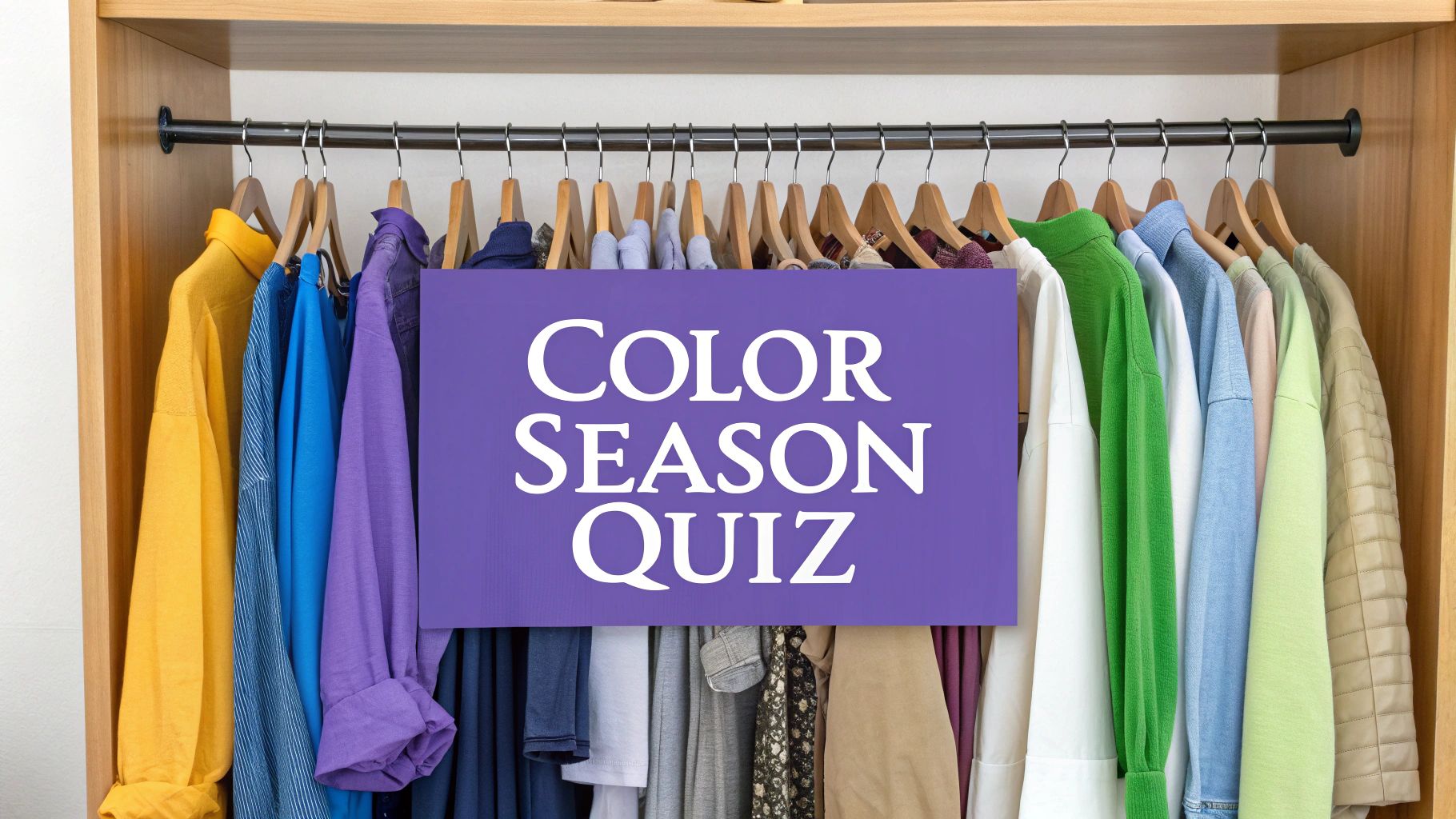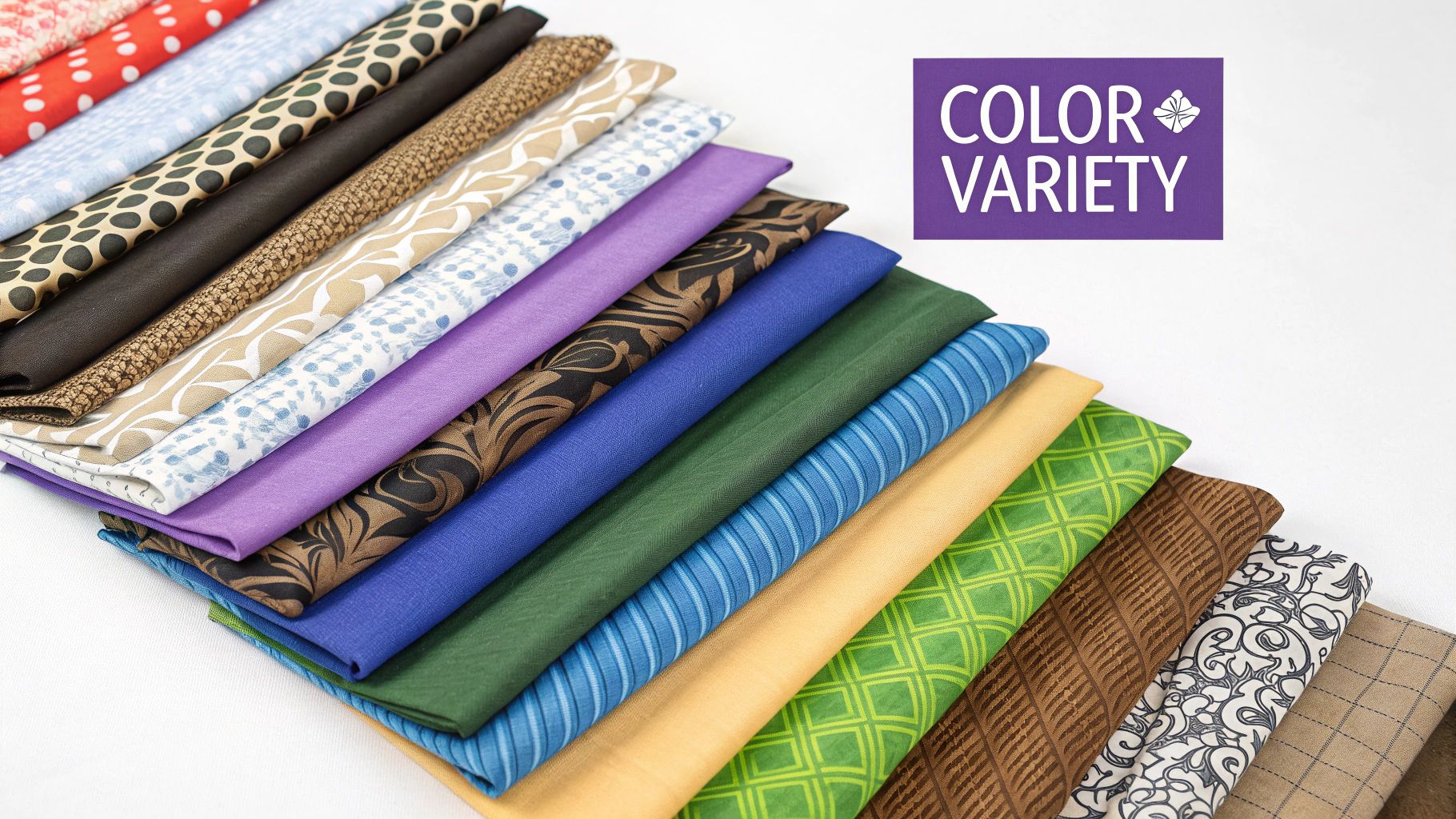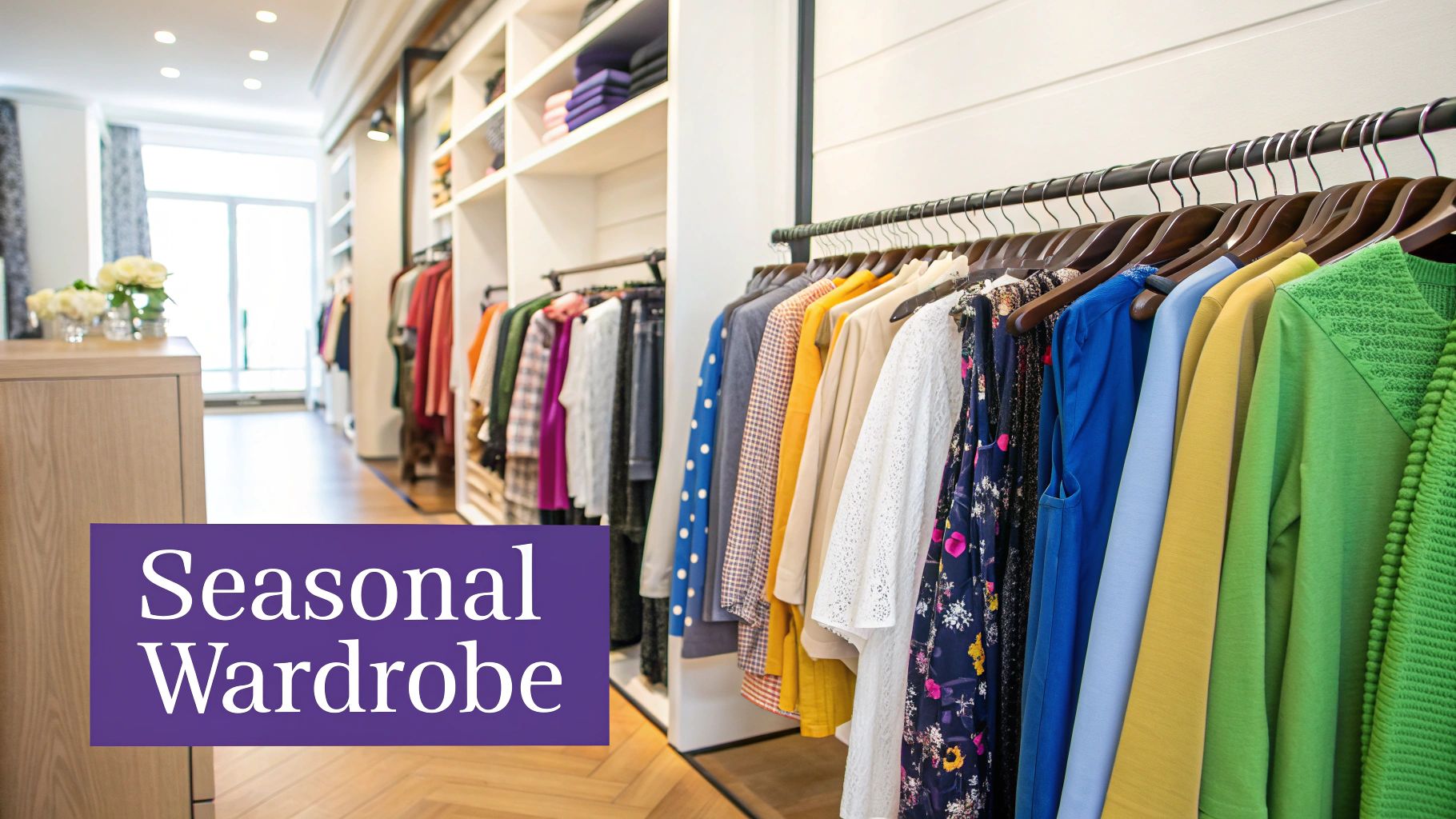
What Is My Color Season Quiz: The Ultimate Guide to Finding Your Perfect Color Palette
By Emma Johnson - 8/14/2025
Understanding Color Season Analysis: Your Journey to Personal Style
Color season analysis provides a helpful framework for finding your most flattering colors. This method matches your natural features with the most complementary color palettes, helping you make smart choices about clothing, makeup, and hair color. When you wear colors that work with your natural coloring, you can express your authentic style with confidence. You might be interested in: How to master your perfect color palette.
The system identifies your dominant coloring characteristics and places you into one of four seasonal categories: Spring, Summer, Autumn, or Winter. Each season has its own unique palette designed to harmonize with specific combinations of skin tone, hair color, and eye color. Rather than just picking colors you like, this approach helps determine which ones truly make you look your best.
Color analysis gained major popularity in the 1980s through Carole Jackson's influential book Color Me Beautiful. Her work made color analysis accessible by introducing the four-season framework that continues to shape fashion and beauty choices today. Her systematic approach helped people understand how to choose colors based on their natural features. Learn more about the history: The origins of seasonal color analysis.
Decoding the Nuances of Color Seasons
While the four main seasons provide a foundation, color analysis goes deeper by recognizing subtle variations within each category. For instance, if you're a Summer, you might specifically be a Light Summer, Soft Summer, or Cool Summer. These subcategories account for individual differences, since no two people have exactly the same coloring, even within the same season.
Why "What Is My Color Season Quiz" Matters
Taking a color season quiz is your first step toward discovering your most flattering colors. These assessments evaluate your natural coloring to match you with your ideal seasonal palette. Understanding your color season gives you a practical tool for making style choices that highlight your best features and helps explain why certain colors make you glow while others don't work as well.
The Benefits of Knowing Your Color Season
Knowing your seasonal color type offers several key advantages:
- Enhanced Appearance: When you wear your best colors, your skin looks healthier, your eyes appear brighter, and your overall look becomes more balanced and natural
- Simplified Shopping: Shopping becomes more focused when you know which colors to look for, helping you avoid impulse buys and build a more purposeful wardrobe
- Increased Confidence: Wearing colors that truly suit you builds self-assurance and projects polish, especially in professional and social settings
- Versatile Wardrobe Building: A wardrobe based on your color season creates an easily mixed-and-matched collection that works well together
Taking a color season quiz provides the foundation for building a wardrobe that brings out your natural beauty. This knowledge helps you develop a signature style that feels authentic and looks effortlessly put-together.
Mastering The Four Seasons: Beyond Basic Color Categories
Color season analysis groups people into Spring, Summer, Autumn, and Winter based on their hair, skin, and eye colors. But getting the most out of this system requires going deeper than these basic categories to understand the subtle differences that create 12 distinct subtypes.
Uncovering the Sub-Seasons
Professional analysts know that even within one season, people's coloring can vary quite a bit. Two Summers might look noticeably different - one could have cool ash blonde hair with rosy skin, while another has warmer golden blonde hair and peachy undertones. This is where sub-seasons come in, offering more precise color recommendations for each person.
These sub-seasons, also called tonal seasons, add precision to the four-season approach. Rather than just being labeled a "Summer," you might be a Light Summer, Soft Summer, or Cool Summer - each with colors specifically chosen to match your features. Getting to know these subtypes helps you make the most of color's impact on your appearance.
Understanding the 12 Tonal Seasons
Building on the work of color analysts like Suzanne Caygill, the system breaks down each main season into three variations, creating 12 season types. These include Light Summer, Soft Summer, Cool Summer, Soft Autumn, Warm Autumn, Deep Autumn, Clear Winter, Cool Winter, Deep Winter, Light Spring, Clear Spring, and Warm Spring. This detailed breakdown helps find the most flattering colors for each individual. Learn more about finding your season

Recognizing Your Own Seasonal Indicators
Before taking a color season quiz, start by looking at your natural coloring. Check your skin's undertones in natural light - are they warm and golden, or cool and rosy? Look at your hair and eye colors - are they light and bright, or deep and rich? These observations give important clues about your dominant features and likely color season.
The 12 sub-seasons make color analysis more precise and effective. This detailed approach goes beyond basic categories, helping you pick colors that truly complement your unique features. Understanding the science and psychology behind color analysis adds another fascinating layer to this practical tool.
The Science and Psychology Behind Color Analysis
Color choices can powerfully impact how we look and feel. The field of color analysis examines how specific colors interact with our natural features and influence perceptions. Let's explore the evidence and principles behind this fascinating approach to personal style.
Color Theory and Personal Coloring
The foundation of color analysis comes from traditional color theory principles about how different hues interact and create visual effects. When applied to personal appearance, this suggests that certain color palettes work better with specific combinations of skin tone, hair color, and eye color. For example, someone classified as a "Spring" often looks vibrant in warm, clear colors, while "Winter" types shine in cool, high-contrast shades. Learn more in our article about understanding skin undertone.
The Psychological Impact of Color
Research shows that colors can affect our emotions and behaviors in significant ways. While individual and cultural factors influence these responses, certain color associations are widely recognized across populations. For instance, blue tends to evoke feelings of calm and trust, while red often stimulates energy and excitement. Color analysis considers these psychological effects when recommending palettes.
Examining the Evidence
The scientific support for traditional color analysis systems remains a topic of discussion. While many professionals use these methods successfully, most evidence comes from practical experience rather than controlled studies. Watch this video for more context: Exploring the basis of color analysis. However, research does confirm that personal coloring affects how others perceive us, supporting the basic idea that choosing flattering colors can enhance our appearance.
A Balanced Perspective on Color Analysis
While seasonal color categories may lack extensive scientific validation, millions of people have found color analysis helpful for developing their personal style. The key is taking a practical approach - use color analysis as a starting point for discovering which colors make you look and feel your best. Think of it as a creative tool for self-expression rather than strict rules to follow. With this mindset, color analysis becomes an enjoyable way to explore and enhance your natural coloring.
Taking Your Color Season Quiz: A Step-by-Step Success Guide
Finding your most flattering colors through a color season quiz can be a game-changing experience. The key to getting reliable results lies in proper preparation and testing methods. This guide will help you make the most of your color analysis, whether you opt for a virtual or in-person assessment.
Setting the Stage for Accurate Results
Creating the right testing environment is essential for getting accurate results. Natural, indirect daylight provides the ideal setting for color analysis. Avoid testing in direct sunlight or under fluorescent lights, as these can distort how colors appear on your skin. Think of it like photography - the right lighting reveals true colors, while poor lighting creates misleading results.
For the most accurate assessment, wear neutral-colored clothing like white or light gray. These colors won't interfere with the draping process. Skip makeup for your analysis since it can affect how colors interact with your natural skin tone.

Assessing Your Natural Coloring
Before starting the quiz, take time to study your natural features. Note details about your skin's undertones (warm or cool), hair color (light or dark, bright or muted), and other defining characteristics. This self-awareness helps you better understand quiz questions and interpret your results.
Virtual vs. In-Person Analysis: Choosing the Right Approach
Both virtual and in-person color analyses have their benefits. In-person consultations offer personal attention from trained experts who can spot subtle variations in your coloring. Virtual options like AI Color Analysis provide easy access to color insights from the comfort of home, often at a lower cost.
Common Pitfalls to Avoid
Watch out for these frequent mistakes that can affect your quiz results:
- Moving too quickly through the questions instead of giving each careful thought
- Testing in poor lighting conditions that alter color perception
- Wearing makeup that masks your natural coloring
- Doubting your first impressions instead of trusting your instincts
Maximizing the Accuracy of Your Color Analysis
Getting reliable results means paying attention to testing conditions that can impact your outcome. Small details like background colors and clothing choices make a big difference - for example, wearing bright colors can reflect onto your skin and create misleading results. Following the steps in this guide helps ensure your color season quiz provides accurate insights you can use to enhance your personal style. With proper preparation, you'll gain valuable knowledge about the colors that truly make you shine.
Understanding Your Results: From Analysis to Action
You've taken a color season quiz and discovered which season you are - now what? This discovery opens up exciting possibilities for enhancing your personal style. Understanding your seasonal color profile goes beyond just knowing if you're a Spring, Summer, Autumn, or Winter - it's about using that knowledge to make informed style choices that showcase your natural features.
Interpreting Your Color Palette
Each season includes specific colors designed to work with your natural coloring. Springs look best in warm, bright shades like coral and periwinkle, while Autumns shine in earth tones like olive and burnt orange. Pay attention to your specific sub-season too - a Light Spring's best colors differ from a Warm Spring's. These subtle variations can make a noticeable difference in how colors look on you.
Adapting Recommendations to Your Personal Style
Your color season provides helpful guidelines without limiting your style expression. For example, if you're a Winter who prefers minimalist fashion, focus on cool neutrals like charcoal and navy as your base, adding touches of icy pink or sapphire blue as accents. This approach lets you use your seasonal colors while staying true to your preferred aesthetic.
Building a Versatile Wardrobe
Think of your seasonal palette as the foundation for creating a wardrobe where pieces work together naturally. When shopping, consider how new items fit with your existing clothes in complementary seasonal colors. This mindful approach helps prevent impulse purchases and creates a more cohesive collection that's easy to mix and match.
Making Informed Purchasing Decisions
Understanding your best colors helps you shop more effectively. Before buying that beautiful dress in a color outside your palette, pause to consider if a similar style in one of your flattering colors might be a better choice. This awareness leads to smarter purchases and a wardrobe filled with pieces that truly enhance your appearance.
Troubleshooting Common Challenges
It's normal if some colors within your season don't work perfectly for you. For instance, a True Summer might find certain pastels too light. Focus on the shades that make you look and feel your best, even if that means using only part of your seasonal palette. Experimentation is key - try different variations of your season's colors to find your perfect matches.
Expert Advice for Color Combinations
While wearing single colors from your palette is reliably flattering, exploring color combinations can add interest to your outfits. Look for style inspiration showing how others with your color season pair different shades. This can spark ideas for creating your own dynamic looks while staying within your most flattering color family.
Living Your Colors: Practical Applications for Every Day

You've taken a color analysis quiz and found your perfect seasonal palette. Now comes the fun part - putting this knowledge into practice. By understanding how to apply your colors effectively, you can build a wardrobe and style that makes you look and feel amazing.
Building a Cohesive Wardrobe
Your seasonal color palette provides a framework for creating outfits that work well together. Rather than matching exact shades, focus on combining colors within your seasonal family. For example, if you're a Spring, you might pair a soft yellow top with olive pants for a naturally coordinated look.
Consider starting a capsule wardrobe with fewer, high-quality pieces in your best colors. This makes getting dressed easier and ensures everything you own is flattering. A well-planned capsule of 20-30 pieces can provide more outfit options than a closet full of mismatched items.
Makeup Selection Tips
Your seasonal colors should guide your makeup choices too. Each season has ideal makeup shades - cool mauves and roses for Summers, rich terracottas and brick reds for Autumns. Choosing the right undertones in your cosmetics helps create a naturally polished look.
Even small details like eyeshadow and lipstick make a big impact when they align with your coloring. The right makeup shades enhance your features while the wrong ones can look harsh or washed out.
Adapting Your Colors for Different Occasions
Your seasonal palette works across various settings with some thoughtful adjustments. Professional environments might call for your softer, more muted shades while special events let you play with bolder colors. The key is staying within your seasonal family while varying the intensity.
A Winter, for instance, could wear a deep navy suit to work and a vibrant fuchsia dress for evening - both colors within their cool, clear palette. This flexibility makes color analysis practical for any situation. You might be interested in: Learn more about the importance of eye and hair color in color analysis.
Transitioning Your Existing Wardrobe
Don't feel pressured to replace everything at once if you have clothes outside your season. Start by adding accessories in your best colors - scarves, jewelry, or bags can refresh existing outfits. This allows for a gradual transition that's both practical and budget-friendly.
As you naturally replace worn items, choose new pieces in your seasonal colors. Over time, your wardrobe will evolve to contain more of your most flattering shades.
Investing in Your Best Colors
Once you know your season, focus on acquiring key pieces in your most impactful colors. A well-fitting jacket, versatile dress, or classic trousers in your best shades become the foundation for countless great outfits.
Choose quality over quantity and invest in colors you know work for you. This builds a wardrobe that helps you look and feel confident every day. Ready to discover your perfect colors? Start your color analysis journey today! Discover Your Perfect Colors Now!
Take your style to the next level with a professional analysis
You already know the theory. Now discover exactly which colors and styles enhance your personal image.
Loading...
Complete PDF report in less than 5 minutes
Your color season and personalized palette
Specific makeup and clothing recommendations
Based on professional color analysis
One-time investment:
One-time payment, no subscriptions. Instant access.